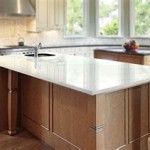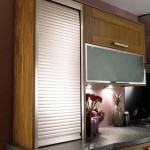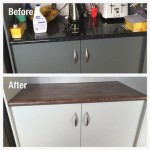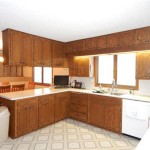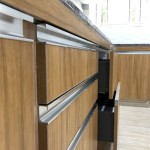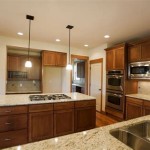How to Paint Kitchen Cabinets Without Taking the Doors Off
Painting kitchen cabinets is a cost-effective way to refresh the look of a kitchen without undertaking a full renovation. While removing the doors and hardware is generally considered the ideal approach for achieving a professional finish, it is possible to paint kitchen cabinets without removing the doors. This method requires more meticulous preparation and technique, but it can save significant time and effort. This article provides a comprehensive guide to painting kitchen cabinets while keeping the doors attached.
Before commencing any painting project, a thorough assessment of the existing cabinet finish is crucial. The type of paint currently on the cabinets, its condition (chipping, peeling, etc.), and the material of the cabinets themselves (wood, laminate, metal) will all influence the necessary preparation steps and the choice of paint and primer. Identifying these factors early on will contribute to a more successful and durable paint job.
Adequate preparation is paramount for a lasting and aesthetically pleasing finish. This includes cleaning, degreasing, sanding, and masking surfaces to protect them from paint. Skipping or skimping on these steps will likely result in paint adhesion issues, uneven coverage, and an overall unprofessional appearance. Dedicate sufficient time to these preparatory stages to ensure the final outcome is satisfactory.
Selecting the right paint and primer is also crucial. For kitchen cabinets, durable and washable paints with a semi-gloss or satin finish are generally recommended. Oil-based paints offer excellent durability but require more specialized cleaning and can have a strong odor. Water-based acrylic or latex paints are easier to work with, dry faster, and are low-odor, making them a popular choice for interior painting. Always use a primer appropriate for the cabinet material and the chosen paint; this will promote adhesion and ensure even color coverage.
Key Point 1: Meticulous Preparation is Essential
The most critical aspect of painting kitchen cabinets without removing the doors is thorough preparation. This process involves multiple stages, each designed to create a clean, smooth, and receptive surface for the paint to adhere to. The following steps detail the necessary preparation work.
First, thoroughly clean the cabinets with a degreasing cleaner. Kitchen cabinets accumulate grease, food splatters, and general grime over time. A strong degreaser, such as trisodium phosphate (TSP) or a TSP substitute, is necessary to remove these contaminants. Apply the cleaner according to the manufacturer's instructions, paying particular attention to areas around handles and hinges. Rinse the cabinets thoroughly with clean water and allow them to dry completely. Residue from the cleaner can interfere with paint adhesion.
Next, scuff-sand the cabinet surfaces. Even if the existing finish is in good condition, sanding is necessary to create a "tooth" for the primer to grip onto. Use a fine-grit sandpaper (220-grit or higher) and lightly sand all surfaces that will be painted. The goal is not to remove the old finish entirely, but rather to roughen it up slightly. Focus on sanding any glossy areas to dull the sheen. After sanding, wipe the cabinets clean with a tack cloth to remove all sanding dust. Dust is a major enemy of any paint job, as it can create a bumpy or uneven finish.
Following sanding, masking is crucial to protect surrounding surfaces from paint splatters and drips. Use painter's tape to carefully mask off the walls, countertops, backsplash, appliances, and any other areas that should not be painted. It is also recommended to cover the floor with drop cloths or plastic sheeting. Pay close attention to detail when masking, ensuring that the tape is firmly adhered to the surfaces to prevent paint from seeping underneath. A wider painter's tape can provide more protection along edges. For areas that are difficult to tape, such as intricate molding, consider using a paint shield.
Once the cleaning, sanding, and masking are complete, inspect the cabinets for any repairs that need to be made. Fill any holes, dents, or scratches with wood filler. Allow the filler to dry completely according to the manufacturer's instructions, and then sand it smooth. Clean the repaired areas with a tack cloth before proceeding to the priming stage.
Key Point 2: Proper Painting Techniques
Once the cabinets are properly prepared, the next step is to apply primer and paint. Employing the correct painting techniques is essential for achieving a smooth, even, and professional-looking finish. Several techniques are particularly useful when painting cabinets with the doors attached.
Begin by applying a coat of primer. Choose a primer that is specifically designed for the type of cabinets you are painting (e.g., wood primer, laminate primer). Apply the primer in thin, even coats, using a high-quality brush or roller. A brush is ideal for painting detailed areas and corners, while a roller is better suited for larger, flat surfaces. Work in the direction of the grain of the wood, if applicable. Allow the primer to dry completely according to the manufacturer's instructions. Priming is critical for adhesion and blocking any existing stains from bleeding through the new paint.
After the primer has dried, lightly sand it with fine-grit sandpaper (320-grit or higher) to create an even smoother surface for the paint. This step is optional but highly recommended for achieving a truly professional finish. Wipe the cabinets clean with a tack cloth to remove any sanding dust.
Apply the first coat of paint using the same techniques as with the primer. Use a high-quality brush and roller to apply thin, even coats of paint. Avoid applying too much paint at once, as this can lead to drips and runs. Work in the direction of the grain of the wood, if applicable. Allow the paint to dry completely according to the manufacturer's instructions. It's generally best to apply multiple thin coats rather than one thick coat for a smoother finish and better durability.
After the first coat of paint has dried, inspect the cabinets for any imperfections, such as drips, runs, or areas with thin coverage. Lightly sand these areas with fine-grit sandpaper and wipe the cabinets clean with a tack cloth. Apply a second coat of paint, again using the same techniques as before. Allow the paint to dry completely.
If necessary, apply a third coat of paint to achieve full coverage and a uniform finish. Allow the paint to dry completely before removing the painter's tape. Pull the tape away slowly and carefully at a 45-degree angle to avoid peeling the paint off the cabinets. Once the tape is removed, inspect the cabinets for any touch-ups that may be needed. Use a small brush to carefully touch up any areas where the paint has peeled or where the coverage is uneven.
Consider application of a clear topcoat for added protection. While not always necessary, a clear topcoat can provide extra durability and protection against scratches, scuffs, and stains. Choose a clear topcoat that is compatible with the paint you have used. Apply the topcoat in thin, even coats, using a high-quality brush or roller. Allow the topcoat to dry completely according to the manufacturer's instructions.
Key Point 3: Managing Hardware and Hinges
Painting around hardware and hinges presents specific challenges when the cabinet doors remain attached. While ideal practice is to remove hardware, there are ways to achieve a quality finish without that step.
The primary option involves meticulous masking. Use painter's tape to carefully mask off all hardware and hinges. This requires patience and precision, especially for intricate hardware designs. Ensure the tape is firmly adhered to the hardware to prevent paint from seeping underneath. Overlap the tape slightly onto the cabinet surface to ensure a clean line. When masking hinges, consider using a craft knife to carefully trim the tape around the edges for a more precise fit.
If the hinges are particularly difficult to mask, consider using a specialized hinge pin removal tool. These tools allow you to temporarily remove the hinge pin, separating the door from the cabinet frame without completely removing the hinge. This allows you to paint around the hinge area more easily. After painting, simply reinsert the hinge pin to reattach the door. Ensure that a lubricant is applied when reinserting the pins to prevent damage to painted surfaces.
An alternative to masking is to carefully paint around the hardware and hinges with a small brush. This requires a steady hand and a lot of patience. Use a high-quality brush with fine bristles and apply the paint in thin, even coats. Avoid getting paint on the hardware or hinges, as this can be difficult to remove. If paint does get on the hardware, wipe it off immediately with a damp cloth.
After the paint has dried, inspect the hardware and hinges for any imperfections. Use a small brush to carefully touch up any areas where the paint has peeled or where the coverage is uneven. If paint has seeped underneath the masking tape, use a craft knife to carefully score the edge of the paint along the tape line. This will help to prevent the paint from peeling off the cabinets when the tape is removed.
Finally, once the paint is completely dry, consider applying a protective sealant to the hardware and hinges to prevent them from rusting or corroding. This is especially important for hardware that is exposed to moisture, such as in the kitchen. Choose a sealant that is specifically designed for metal and apply it according to the manufacturer's instructions.
Painting kitchen cabinets without removing the doors is a feasible project with careful preparation, proper techniques, and attention to detail. By following these guidelines, a homeowner can achieve a refreshed kitchen appearance with a considerable saving of time and effort compared to a full door removal and reinstallation.

How To Paint Cabinets Without Removing Doors House Mix

How To Paint Cabinets Without Removing Doors House Mix

How To Paint Cabinets Without Removing Doors House Mix

How To Paint Cabinets Without Removing Doors House Mix

How To Paint Fake Wood Kitchen Cabinets Simple Made Pretty 2024

How To Paint A Door Without Taking It Off The Hinges Ugly Duckling House

A Step By Guide To Painting Kitchen Cabinets Like Pro

How To Paint Your Kitchen Cabinets In One Weekend Remodelaholic

How To Paint Your Kitchen Cabinets In One Weekend Remodelaholic

How To Paint Laminate Cabinets Without Sanding The Palette Muse
Related Posts

